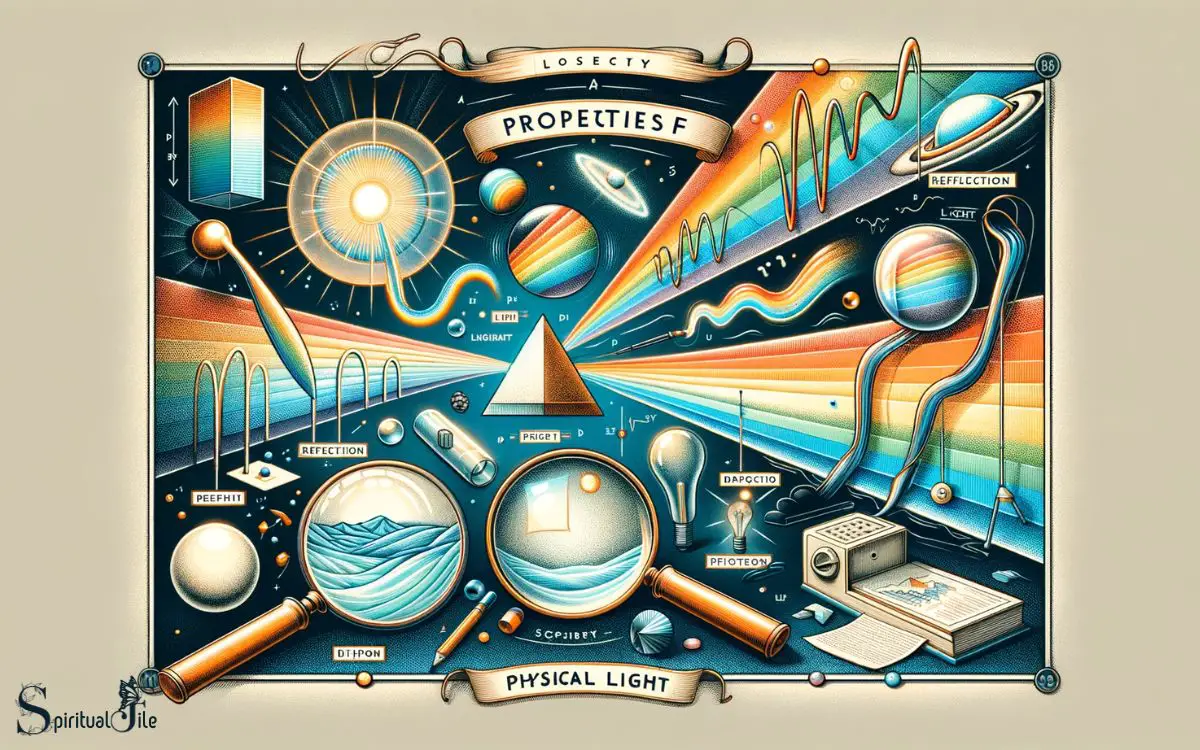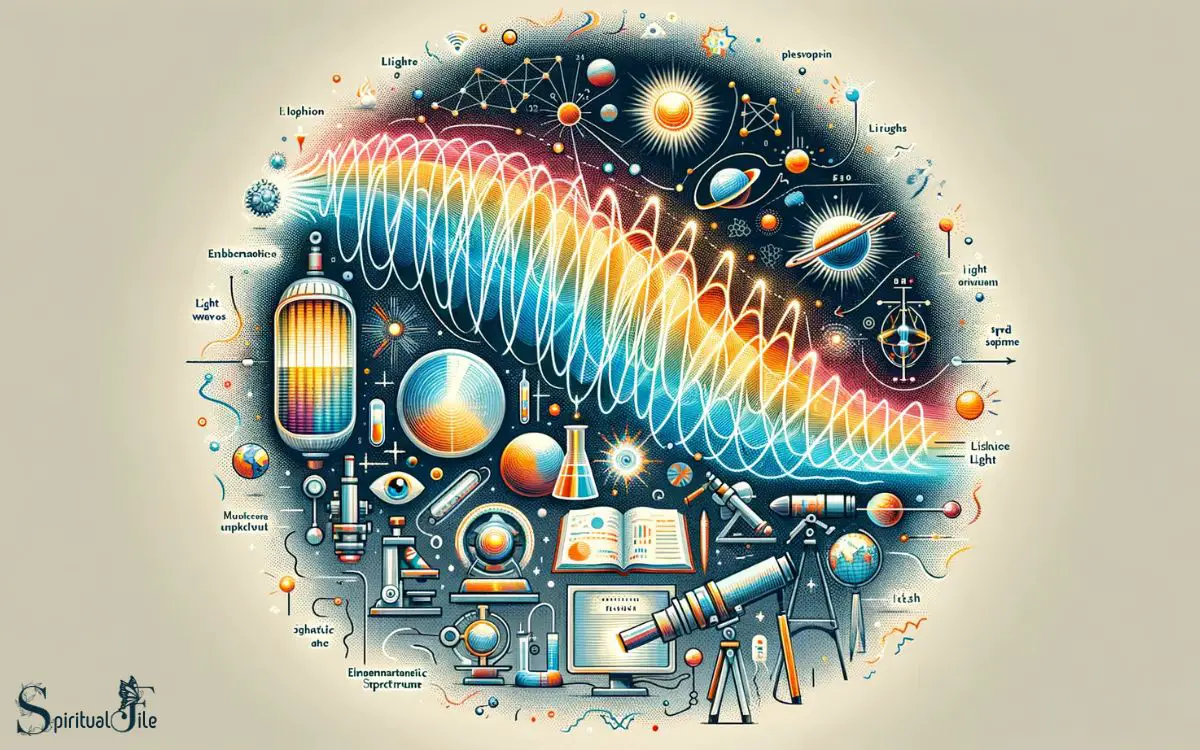Physical Light Vs Spiritual Light: Religions!
Physical light and spiritual light are two distinct forms of illumination that serve different purposes and hold various significances across cultures and religions.
Physical light is the natural phenomenon that enables visual perception, while spiritual light is a metaphorical concept associated with enlightenment and divine presence.
Physical light is a form of electromagnetic radiation visible to the human eye, essential for life on Earth. It is emitted by the sun and artificial sources, allowing us to see and interact with our environment.
Spiritual light, on the other hand, is not a tangible entity but a symbol often found in religious and philosophical contexts. It represents truth, wisdom, and the inner illumination of the soul.
Physical Light:
- Source: Sun, bulbs, fire
- Purpose: Enables sight, regulates biological cycles
- Properties: Wavelength, frequency, intensity
Spiritual Light:
- Source: Deity, inner self, universal energy
- Purpose: Symbolizes purity, goodness, enlightenment
- Properties: Metaphorical, transcendent, inspirational
For example, in Christianity, the phrase ‘Let there be light’ from the creation story in Genesis refers to both the creation of physical light and the introduction of divine wisdom.
The concept of light, whether physical or spiritual, remains a powerful symbol bridging the material and ethereal, guiding our quest for knowledge and transcendent understanding.

Key Takeaway
Physical Light vs Spiritual Light: A Comparative Analysis
| Aspect | Physical Light | Spiritual Light |
|---|---|---|
| Definition | Physical light is electromagnetic radiation within a certain portion of the electromagnetic spectrum that is visible to the human eye. | Spiritual light is a metaphorical concept that represents enlightenment, inner illumination, or the presence of the divine in various religious and philosophical traditions. |
| Source | Sunlight, bulbs (incandescent, fluorescent, LED, etc.), lasers, fire | Divine or transcendental sources, personal growth, moral or ethical enlightenment |
| Nature | Has a dual wave-particle nature, measurable in terms of wavelength, frequency, and intensity. | Intangible, often described in terms of feeling, understanding, or a state of consciousness. |
| Detection | Detected by the eyes and can be measured by instruments. | Perceived through introspection, spiritual experiences, or religious practices. |
| Influence | Affects the physical world, can cause chemical reactions (photosynthesis), and is essential for sight. | Affects the mental, emotional, and spiritual aspects of a person, often associated with guidance, wisdom, and insight. |
| Measurement | Measured in lumens, lux, watts, etc. | Not measurable by physical instruments; often assessed through personal or collective subjective experiences. |
| Symbolism | Light symbolizes clarity, purity, and knowledge. Often used in metaphors and similes. | Light symbolizes hope, faith, purity, and redemption. Commonly found in religious texts and spiritual teachings. |
| Utilization | Used in technology, medicine, architecture, photography, and various other fields. | Used in religious ceremonies, meditation, and as a guide for moral and ethical decision-making. |
The Nature of Light

The nature of light’s dual character as both a tangible and intangible force has intrigued scientists and philosophers for centuries.
On one hand, light behaves as a wave, exhibiting properties such as diffraction and interference. On the other hand, it also behaves as discrete particles called photons, each carrying a specific amount of energy.
This duality is encapsulated in the wave-particle duality theory, which posits that light can exhibit both wave-like and particle-like behavior depending on the conditions of observation.
This fundamental aspect of light has not only revolutionized our understanding of the universe at the quantum level but has also sparked deep philosophical inquiries into the nature of reality itself.
The study of light continues to unravel its mysteries, captivating the minds of both scientists and thinkers alike.
Properties of Physical Light

An understanding of various measurable properties of physical light is essential for comprehending its behavior and interactions with matter.
When examining the properties of physical light, the following aspects are crucial to consider:
- Wavelength: The distance between successive peaks of a light wave, which determines its color and energy. Shorter wavelengths appear bluer and carry more energy, while longer wavelengths appear redder and carry less energy.
- Intensity: The amount of energy transmitted per unit time through a unit area and is perceived as the brightness of light. It is important in understanding how light interacts with objects and its impact on human vision.
- Speed: The speed of light in a vacuum, which is a fundamental constant and plays a key role in various scientific equations.
Understanding these properties provides a foundation for comprehending the behavior and significance of physical light.
Spiritual Light in Religion

The concept of spiritual light holds profound significance in various religious traditions. It is often employed as a symbolic representation of divine presence and enlightenment, serving as a source of guidance and hope for believers.
Within this context, spiritual light is associated with the inner illumination of faith and the pursuit of higher consciousness, offering a lens through which individuals can seek clarity and understanding in their spiritual journeys.
Symbolism in Religious Light
Symbolism plays a significant role in religious light, representing spiritual enlightenment and divine presence across various faith traditions.
This symbolism conveys deeper meanings, such as:
- Guidance: Light symbolizes the guiding influence of spiritual teachings, leading individuals out of darkness and towards truth and understanding.
- Purification: It represents the purifying aspect of spiritual practice, illuminating the path towards moral and ethical purity.
- Connection with the Divine: Light is often seen as a manifestation of the divine presence, signifying the illumination of the soul and the connection with a higher power.
Understanding these symbolic representations of light in religion provides insight into the profound spiritual concepts and beliefs that have been integral to various religious traditions throughout history.
Divine Enlightenment and Faith
Representing divine enlightenment and faith, the abstract concept of spiritual light in religion encompasses the profound connection between individuals and the divine presence.
This spiritual light is often described as a guiding force, illuminating the path of believers and providing clarity in times of darkness.
In various religious traditions, such as Christianity, Islam, Buddhism, Hinduism, and others, spiritual light symbolizes the awakening of inner consciousness, the pursuit of truth, and the embodiment of virtues like love, compassion, and wisdom.
It serves as a metaphor for the presence of the divine within individuals, inspiring hope, resilience, and a sense of purpose.
Through embracing this spiritual light, adherents seek to deepen their faith, find solace in times of struggle, and ultimately, attain a state of transcendence beyond the material world.
Inner Illumination and Guidance
Inner illumination in religion signifies the spiritual guidance experienced by believers.
This profound concept encompasses various aspects that are pivotal in understanding the significance of spiritual light in religion:
- Divine Presence: Inner illumination is believed to be a manifestation of the divine presence within individuals, providing them with clarity and insight.
- Moral Direction: It serves as a moral compass, guiding individuals towards virtuous paths and ethical conduct.
- Personal Transformation: Inner illumination is seen as a catalyst for personal transformation, leading individuals towards spiritual growth and enlightenment.
Understanding the depth of inner illumination in religion illuminates the profound impact of spiritual light on individuals’ lives, guiding them towards fulfillment and spiritual awakening.
This spiritual understanding of light in religion sets the stage for exploring the scientific understanding of light.
Scientific Understanding of Light

Understanding light from a scientific perspective involves exploring its wave-particle duality. This concept challenges traditional notions of particles and waves, offering a complex and intriguing concept to explore.
Delving into the electromagnetic spectrum is another crucial aspect of understanding light. The electromagnetic spectrum is a vast expanse that opens doors to a multitude of applications and discoveries.
It encompasses various forms of electromagnetic radiation, from radio waves to gamma rays, each with its own unique properties and interactions with matter.
Comprehending the incredible speed of light in a vacuum is also essential. The speed of light, denoted by the symbol “c,” is a fundamental constant in the universe.
It serves as a benchmark for understanding other phenomena and has significant implications for our understanding of space and time.
Wave-Particle Duality in Light
The scientific understanding of light encompasses its dual nature as both a wave and a particle. This wave-particle duality is a fundamental concept in quantum mechanics and explains the behavior of light at different scales.
To delve deeper into this duality, it’s essential to consider:
- Wave Behavior: Light exhibits wave-like properties such as interference and diffraction, which are characteristic of waves.
- Interference: When two light waves overlap, they can either reinforce or cancel each other out, leading to interference patterns.
- Diffraction: Light waves can bend around obstacles, demonstrating their wave nature.
- Particle Behavior: Light also behaves as a stream of particles called photons, each carrying discrete amounts of energy and momentum.
- Quantum Mechanics: Wave-particle duality challenges classical physics and is best described by quantum mechanics, where the behavior of light is understood through probabilities and wave functions.
This understanding sets the stage for exploration into the electromagnetic spectrum.
Electromagnetic Spectrum Exploration
Exploring the scientific understanding of light through the electromagnetic spectrum reveals the diverse range of wavelengths and energies encompassed by this fundamental aspect of physics.
The electromagnetic spectrum encompasses all forms of light, from radio waves with the longest wavelengths and lowest energies to gamma rays with the shortest wavelengths and highest energies.
This spectrum includes familiar forms of light such as visible light, infrared, and ultraviolet, as well as less well-known forms such as microwaves and X-rays.
Each type of light carries unique properties and has diverse applications across various scientific and technological fields. The following table highlights the different types of electromagnetic radiation, their wavelengths, frequencies, and typical applications:
| Type of Radiation | Wavelength (m) | Frequency (Hz) | Typical Applications |
|---|---|---|---|
| Radio Waves | Long | Low | Communication |
| Microwaves | Medium | Medium | Cooking, Communication |
| Infrared | Medium | Medium | Thermal Imaging, Remote Controls |
| Visible Light | Short | High | Vision, Photography |
| Ultraviolet | Short | High | Sterilization, Fluorescent Lamps |
Light Speed in Vacuum
Light speed in vacuum, a fundamental concept in physics, is a constant value denoted by the letter ‘c’ and is a crucial parameter in the scientific understanding of light.
- The speed of light in a vacuum is approximately 299,792,458 meters per second, and it is considered the ultimate speed limit in the universe.
- This speed remains constant regardless of the motion of the source or the observer, as stated in Einstein’s theory of special relativity.
- The constancy of the speed of light plays a pivotal role in various phenomena, including time dilation, length contraction, and the equivalence of mass and energy.
Understanding the implications of light speed in vacuum provides a foundation for comprehending the behavior and significance of light in the physical world. This understanding also lays the groundwork for exploring the symbolism of spiritual light.
Symbolism of Spiritual Light

One key aspect of spiritual teachings is the profound significance of light as a symbol of enlightenment and divine presence.
In various religious and spiritual traditions, light is often used metaphorically to represent the presence of the divine, spiritual awakening, and the illumination of truth.
The symbolism of spiritual light is rich and diverse, with interpretations varying across different belief systems.
Here is a table summarizing the symbolism of spiritual light in some major traditions:
| Tradition | Symbolism of Light |
|---|---|
| Christianity | Symbol of Christ as the “light of the world” |
| Buddhism | Representation of wisdom and the path to enlightenment |
| Hinduism | Significance of inner light and illumination of the soul |
Understanding the symbolism of spiritual light in these traditions provides insight into the universal significance of light as a symbol of spiritual awakening and divine presence.
Effects of Physical Light

The impact of physical light on human physiology and cognition is a well-documented phenomenon in various scientific disciplines. The effects of physical light encompass more than just visibility, extending into the realms of human health and behavior.
Here are some key points to consider:
- Biological Rhythms: Physical light, particularly natural sunlight, plays a crucial role in regulating our internal biological clock, influencing sleep-wake cycles and hormone production.
- Mood and Mental Health: Exposure to natural light has been linked to improved mood and mental well-being, while insufficient light can contribute to conditions like seasonal affective disorder.
- Cognitive Performance: Studies have shown that adequate lighting levels enhance cognitive function, concentration, and productivity, particularly in educational and work environments.
Understanding the multifaceted impact of physical light underscores its significance in shaping human experiences and overall well-being.
Inner Enlightenment Through Spiritual Light

Through contemplation and meditation, individuals can achieve inner enlightenment, connecting with spiritual light to gain insight and understanding beyond the physical realm.
This inner enlightenment is a state of heightened awareness and clarity that allows individuals to perceive the interconnectedness of all things and gain a deeper understanding of their purpose and place in the universe.
Spiritual light serves as a guiding force, illuminating the path to self-discovery and providing a profound sense of peace and fulfillment.
By embracing spiritual light, individuals can transcend the constraints of the material world and tap into a source of wisdom and guidance that fosters personal growth and transformation.
This inner enlightenment fosters a sense of harmony and unity, enabling individuals to navigate life’s challenges with grace and resilience.
How do Different Religions View the Connection Between Spiritual and Physical Light?
Different religions have varying perspectives on the connection between spiritual and physical light. Some believe that spiritual light can only be perceived through spiritual eyes versus physical eyes. In contrast, others view physical light as a reflection of spiritual enlightenment, which can be recognized through both spiritual and physical eyes.
FAQ About Physical Light Vs Spiritual Light
Can Physical Light Be Transformed Into Spiritual Light?
Transformation from physical light to spiritual light is a concept that varies across belief systems.
Some view spiritual light as symbolic or metaphorical, while others see it as a tangible energy. Ultimately, this question is rooted in philosophical and spiritual interpretations.
How Does the Concept of Spiritual Light Differ Across Different Religious Beliefs?
The concept of spiritual light varies across religious beliefs, representing divine illumination, enlightenment, or the presence of the divine.
This can manifest as wisdom, guidance, or a connection to the transcendent in different faith traditions.
Is There a Connection Between the Effects of Physical Light and Inner Enlightenment Through Spiritual Light?
The connection between the effects of physical light and inner enlightenment through spiritual light is a topic of interest.
Exploring this relationship involves understanding the impact of external stimuli on internal experiences and consciousness.
Can Scientific Understanding of Light Help Us Comprehend Spiritual Light?
Scientific understanding of light can provide a framework for comprehending spiritual light by exploring commonalities in their properties and effects. This approach may offer insight into the nature of spiritual light.
What Are the Practical Ways to Bring More Spiritual Light Into Our Lives?
To bring more spiritual light into our lives, we can engage in mindfulness practices, seek wisdom from spiritual texts, cultivate compassion and gratitude and surround ourselves with positive and uplifting influences.
Conclusion
The comparison between physical light and spiritual light reveals the diverse roles they play in different aspects of life.
While physical light is a fundamental element of the natural world, spiritual light holds a significant symbolic and religious significance.
How can these two forms of light coexist and complement each other in our understanding of the world and our inner enlightenment?






